1994 CHEVROLET S10 service indicator
[x] Cancel search: service indicatorPage 75 of 340
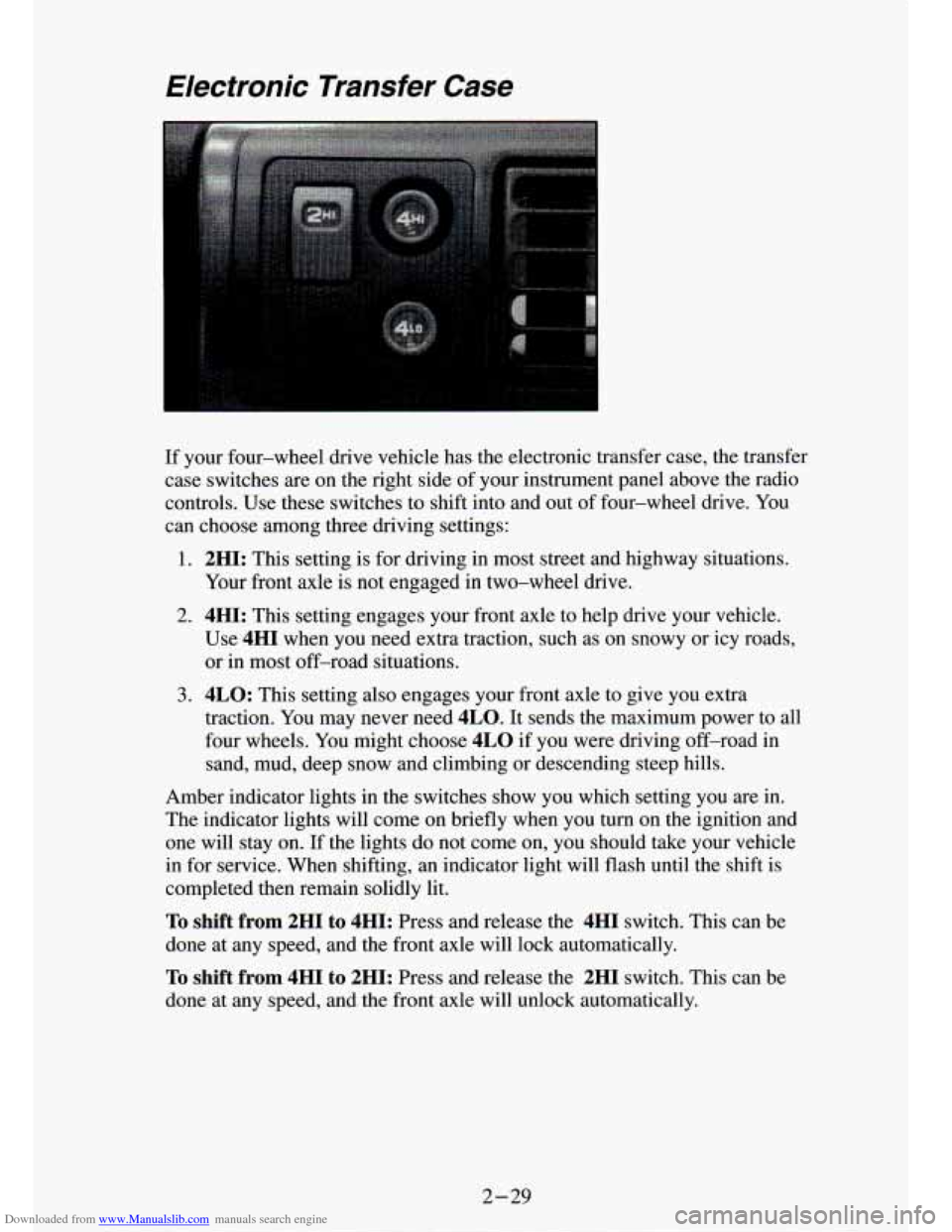
Downloaded from www.Manualslib.com manuals search engine Electronic Transfer Case
If your four-wheel drive vehicle has the electronic transfer case, the transfer
case switches are on the right side of your instrument panel above the radio
controls. Use these switches to shift into and out of four-wheel drive. You
can choose among three driving settings:
1. 2HI: This setting is for driving in most street and highway situations.
Your front axle is not engaged
in two-wheel drive.
2. 4HI: This setting engages your front axle to help drive your vehicle.
Use
4HI when you need extra traction, such as on snowy or icy roads, \
or in most off-road situations.
3. 4LO: This setting also engages your front axle to give you extra
traction. You may never need
4LO. It sends the maximum power to all
four wheels. You might choose
4LO if you were driving off-road in
sand, mud, deep snow and climbing or descending steep hills.
Amber indicator lights in the switches show you which setting \
you are in.
The indicator lights will come on briefly when you
turn on the ignition and
one
will stay on. If the lights do not come on, you should take your vehicle
in for service. When shifting, an indicator light will flash until the shift is
completed then remain solidly lit.
To shift from 2HI to 4HI: Press and release the 4HI switch. This can be
done at any speed, and the front axle will lock automatically.
To shift from 4HI to 2HI: Press and release the 2HI switch. This can be
done at any speed, and the front axle will unlock
; omaticallv.
2-29
Page 76 of 340
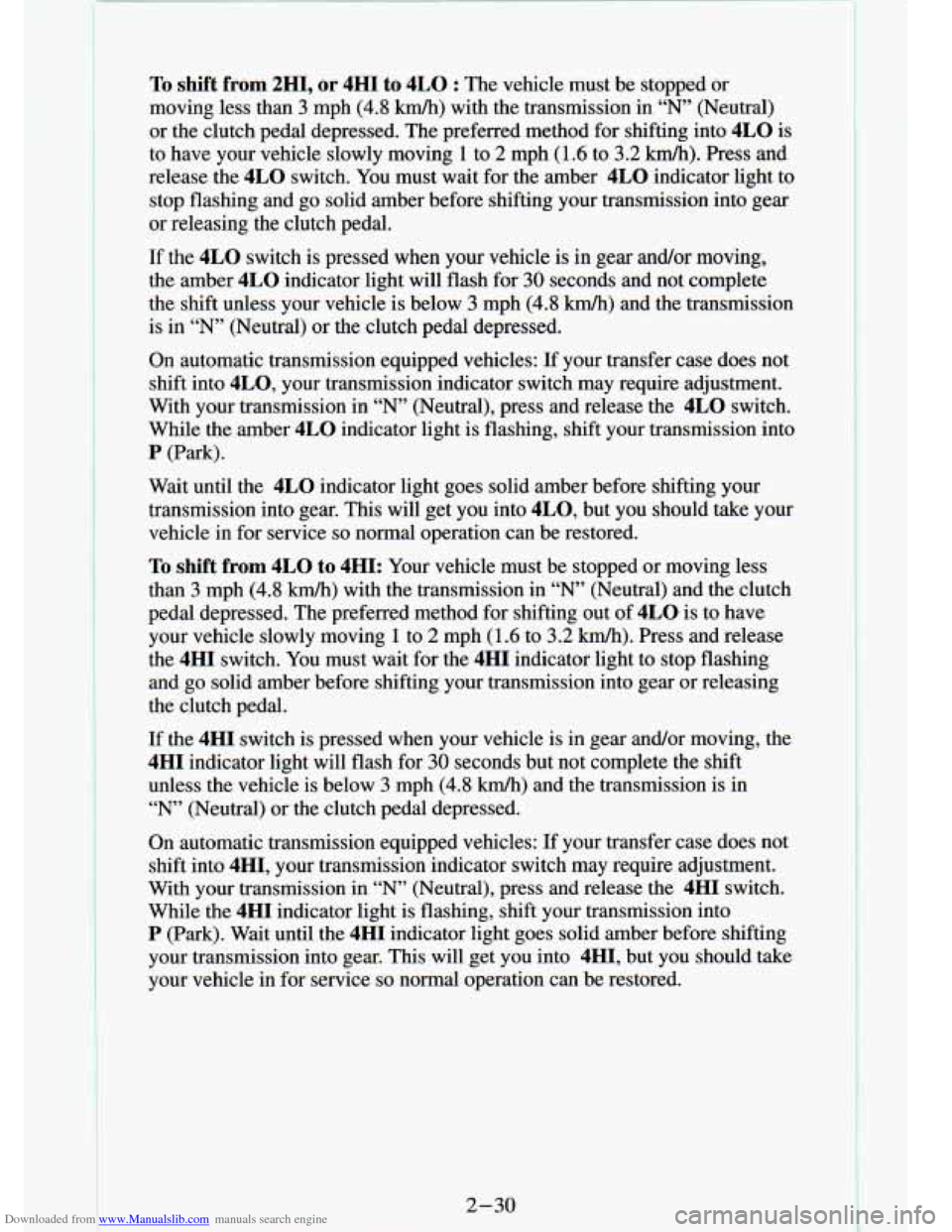
Downloaded from www.Manualslib.com manuals search engine To shift from 2H1, or 4HI to 4LO : The vehicle must be stopped or
moving less than
3 rnph (4.8 km/h) with the transmission in “N” (Neutral)
or the clutch pedal depressed. The preferred method for shifting into
4LO is
to have your vehicle slowly moving
1 to 2 mph (1.6 to 3.2 ludh). Press and
release the
4LO switch. You must wait for the amber 4LO indicator light to
stop flashing and go solid amber before shifting your transmission into
gear
or releasing the clutch pedal.
If the
4LO switch is pressed when your vehicle is in gear and/or moving, \
the amber
4LO indicator light will flash for 30 seconds and not complete
the shift unless your vehicle is below
3 mph (4.8 km/h) and the transmission
is in “N” (Neutral)
or the clutch pedal depressed.
On automatic transmission equipped vehicles: If your transfer case does not
shift into
4L0, your transmission indicator switch may require adjustment.
With your transmission in
“N’ (Neutral), press and release the 4LO switch.
While the amber
4LO indicator light is flashing, shift your transmission into
P (Park).
Wait until the
4LO indicator light go - - solid amber before shifting your
transmission into gear. This will get
you into 4L0, but you should take your
vehicle in for service
so normal operation can be restored.
To shift from 4LO to 4HI: Your vehicle must be stopped or moving less
than
3 mph (4.8 km/h) with the transmission in “N” (Neutral) and the clutch
pedal depressed. The preferred method for shifting out of
4LO is to have
your vehicle slowly moving
1 to 2 mph (1.6 to 3.2 km/h). Press and release
the
4HI switch. You must wait for the 4HI indicator light to stop flashing
and
go solid amber before shifting your transmission into gear or rele\
asing
the clutch pedal.
If the
4HI switch is pressed when your vehicle is in gear and/or moving, the
4HI indicator light will flash for 30 seconds but not complete the shift
unless the vehicle is below
3 mph (4.8 km/h) and the transmission is in
“N’ (Neutral) or the clutch pedal depressed.
On automatic transmission equipped vehicles: If your transfer case does not
shift into
4H1, your transmission indicator switch may require adjustment.
With your transmission in
“N’ (Neutral), press and release the 4HI switch.
While the
4HI indicator light is flashing, shift your transmission into
P (Park). Wait until the 4HI indicator light goes solid amber before shifting
your transmission into gear. This will get you into
4H1, but you should take
your vehicle in for service
so normal operation can be restored.
2-30-
I
Page 107 of 340
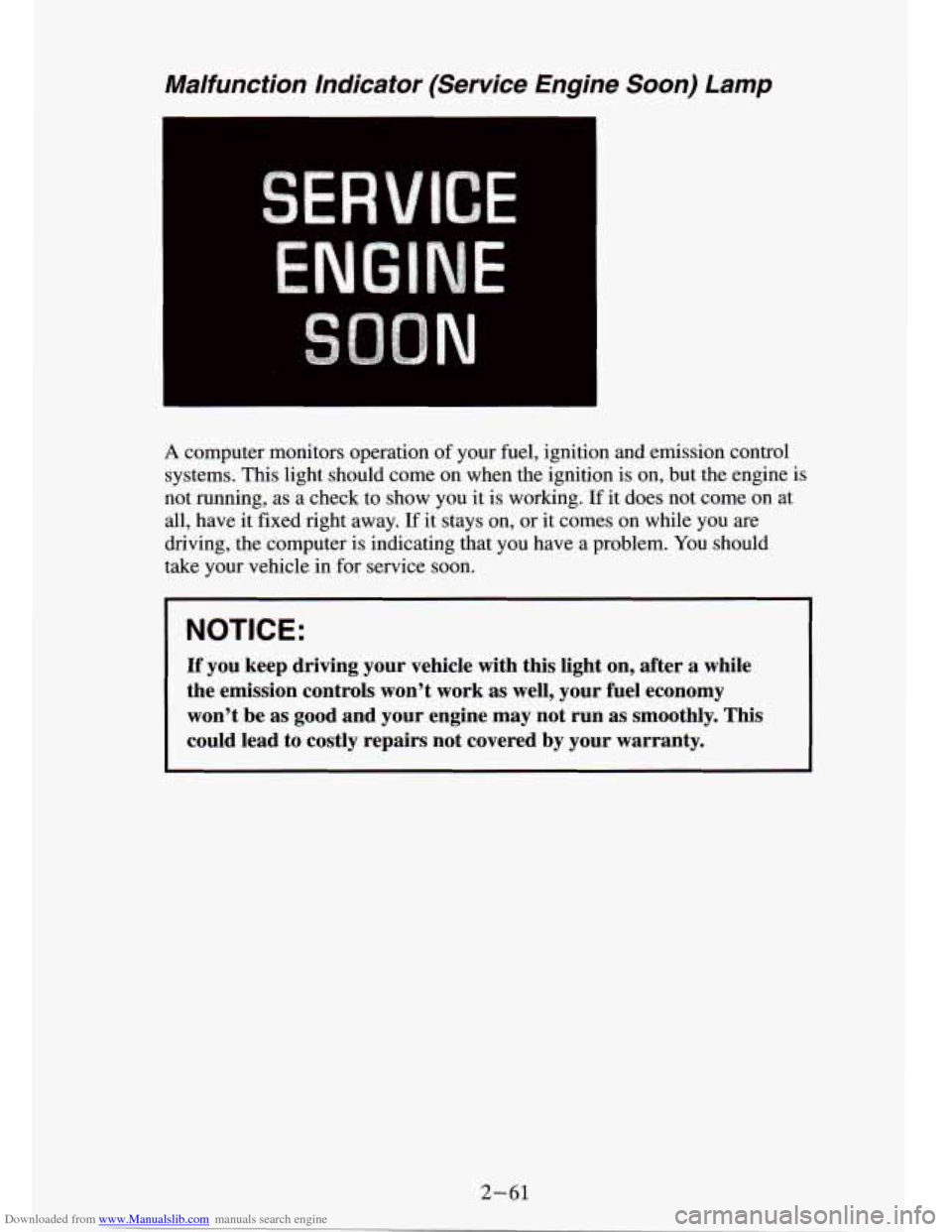
Downloaded from www.Manualslib.com manuals search engine Malfunction Indicator (Service Engine Soon) Lamp
A computer monitors operation of your fuel, ignition and emission control
systems. This light should come on when the ignition
is on, but the engine is
not running, as a check to show you it is working.
If it does not come on at
all, have it fixed right away.
If it stays on, or it comes on while you are
driving, the computer is indicating that you have a problem. You should
take your vehicle in for service soon.
NOTICE:
If you keep driving your vehicle with this light on, after a while
the emission controls won’t work as well, your fuel economy \
won’t be as good and your engine may
not run as smoothly. This
could lead to costly repairs not covered by your warranty.
2-61
Page 262 of 340
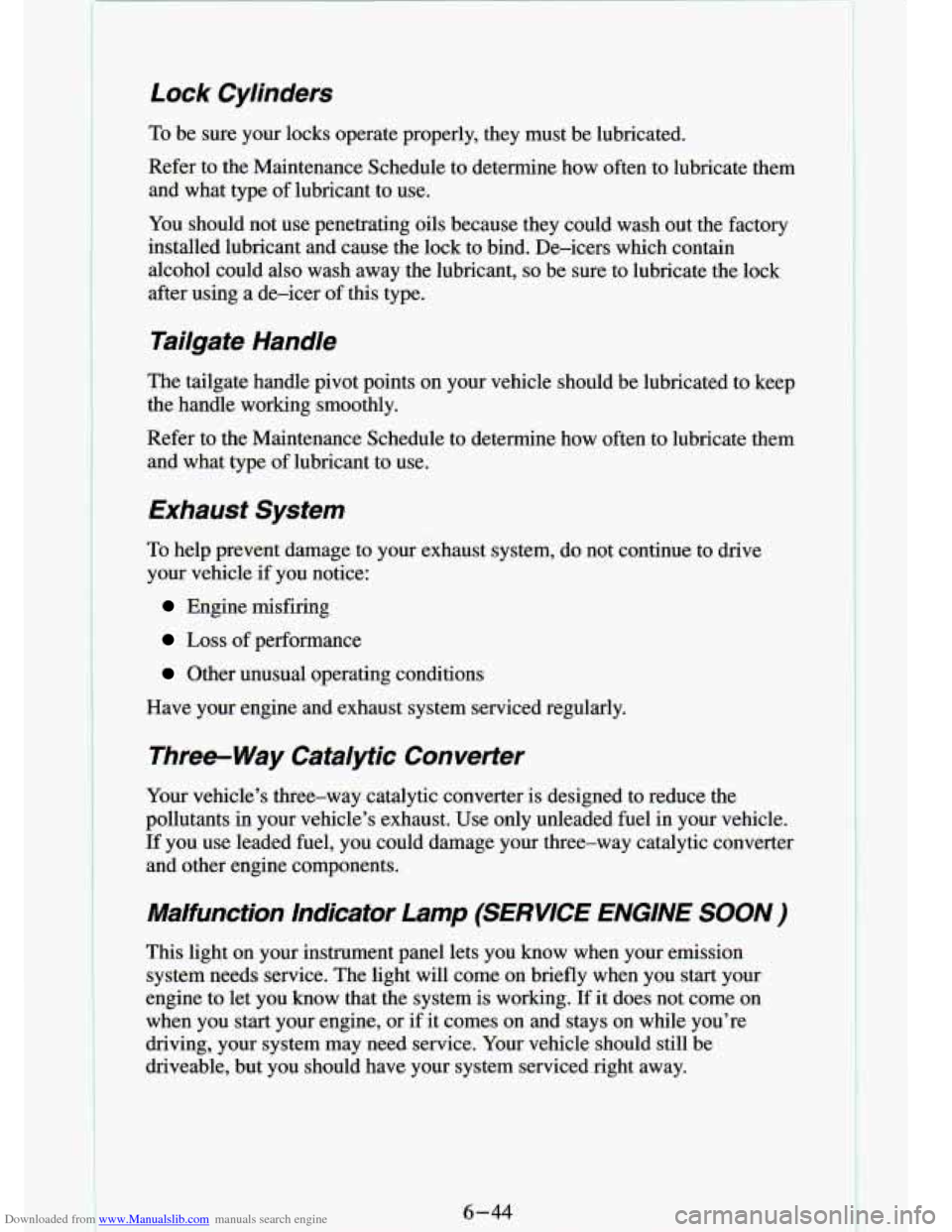
Downloaded from www.Manualslib.com manuals search engine Lock Cylinders
To be sure your locks operate properly, they must be lubricated.
Refer to the Maintenance Schedule to determine
how often to lubricate them
and what type
of lubricant to use.
You should not use penetrating oils because they could wash out the factory
installed lubricant and cause
the lock to bind. De-icers which contain
alcohol could
also wash away the lubricant, so be sure to lubricate the lock
after using a de-icer of this type.
Tailgate Handle
The tailgate handle pivot points on your vehicle should be lubricated to keep
the handle working smoothly.
Refer to the Maintenance Schedule to determine
how often to lubricate them
and what type
of lubricant to use.
Exhaust System
To help prevent damage to your exhaust system, do not continue to drive
your vehicle if you notice:
Engine misfiring
Loss of performance
Other unusual operating conditions
Have your engine and exhaust system serviced regularly.
Three- Way Catalytic Converter
Your vehicle's three-way catalytic converter is designed to reduce the
pollutants in your vehicle's exhaust. Use only unleaded fuel in your vehicle.
If you use leaded fuel, you could damage your three-way catalytic converter
and other engine components.
Malfunction Indicator Lamp (SERVICE ENGINE SOON )
This light on your instrument panel lets you know when your emission
system needs service. The light will come on briefly when you start your
engine to let you know that the system
is working. If it does not come on
when you start your engine, or if it comes on and stays on while you're
driving, your system may
need service. Your vehicle should still be
driveable, but you should have your system serviced right away.
6-44
Page 273 of 340
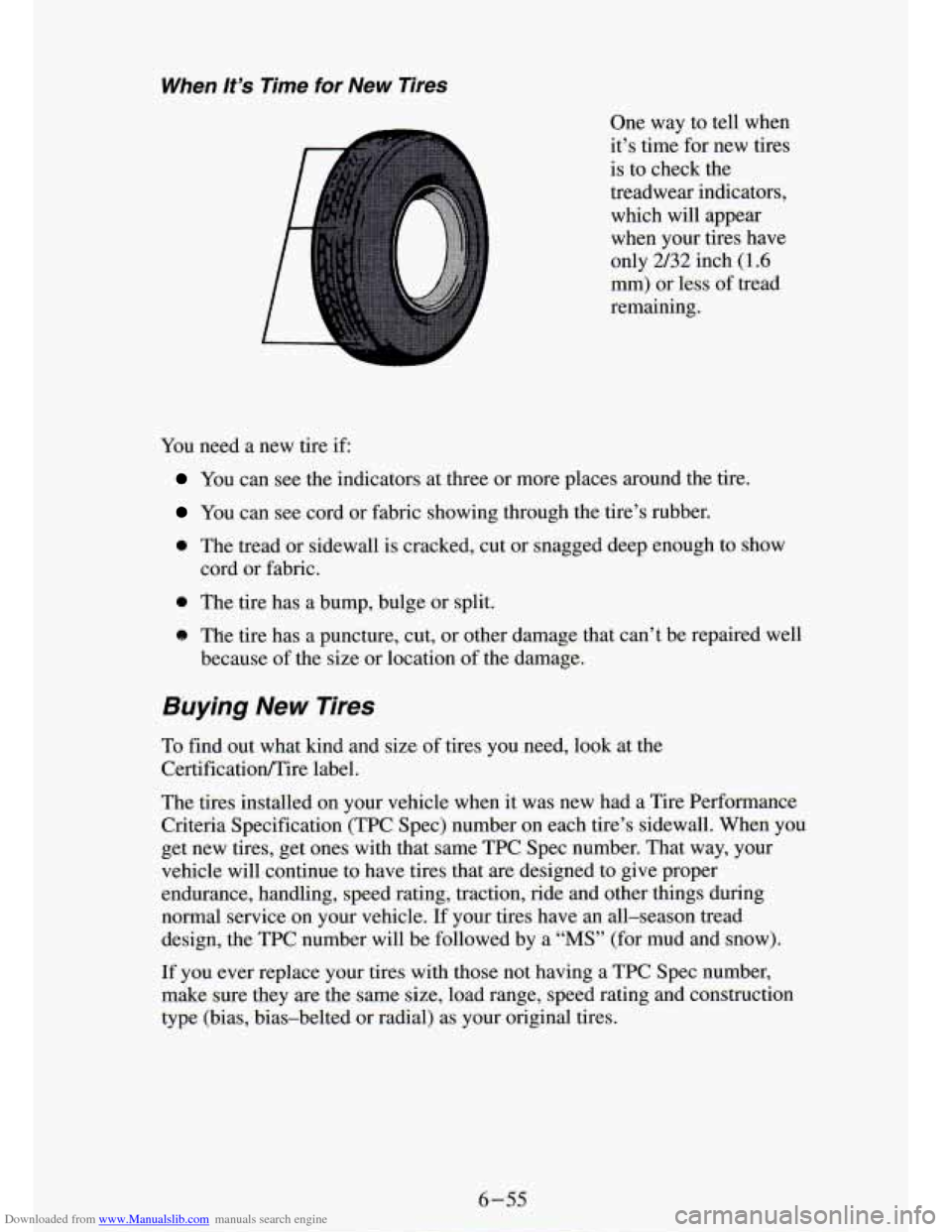
Downloaded from www.Manualslib.com manuals search engine When lt’s Time for New Tires
a
One way to tell when
it’s time for new tires
is to check the
treadwear indicators,
which will appear
when your tires have
only
2/32 inch (1.6
mm) or less of tread
remaining.
You need a new tire if
You can see the indicators at three or more places around the tire.
You can see cord or fabric showing through the tire’s rubber.
0 The tread or sidewall is cracked, cut or snagged deep enough to show
cord or fabric.
0 The tire has a bump, bulge or split.
The tire has a puncture, cut, or other damage that can’t be re\
paired well
because of the
size or location of the damage.
Buying New Tires
To find out what kmd and size of tires you need, look at the
Certificatioflire label.
The tires installed on your vehicle when it was new had a Tire Performance
Criteria Specification (PC Spec) number on each tire’s sidewall. When you
get new tires, get ones with that same TPC Spec number. That way, your
vehicle will continue to have tires that
are designed to give proper
endurance, handling, speed rating, traction, ride and other thin\
gs during
normal service on your vehicle.
If your tires have an all-season tread
design, the TPC number will be followed by a
“MS” (for mud and snow).
If you ever replace your tires with those not having a
TPC Spec number,
make sure they are the same size, load range, speed rating and construction
type (bias, bias-belted or radial) as your original tires.
Page 293 of 340
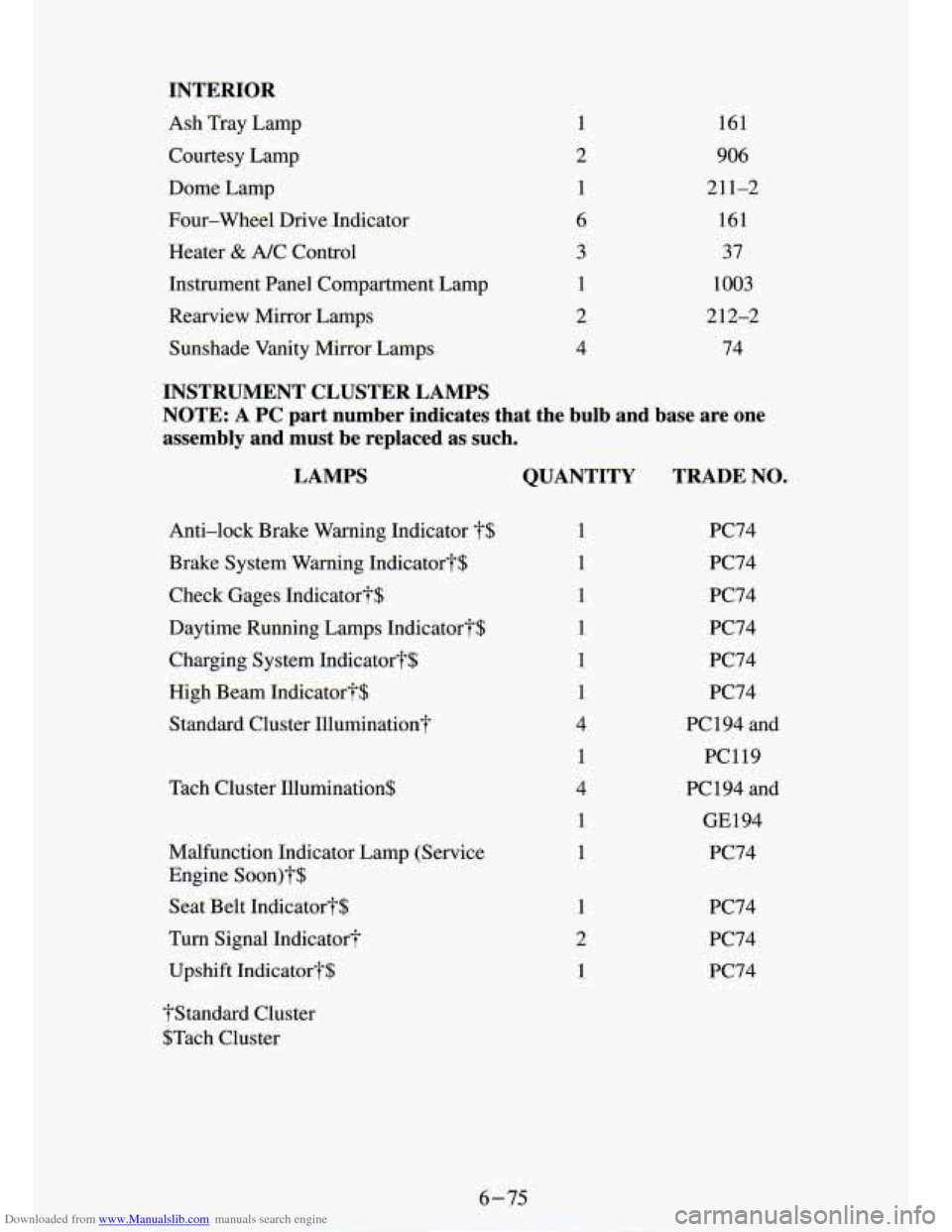
Downloaded from www.Manualslib.com manuals search engine INTERIOR
Ash Tray Lamp
Courtesy Lamp
Dome Lamp
Fol -Wheel Drive - lit, lr
Hearer & A/C Controi
Instrument Panel Compartment Lamp
Rearview Mirror Lamps Sunshade Vanity Mirror Lamps 1
2 1
4 161
906
211-2 161
37
1003
2 12-2
74
INSTRUMENT CLUSTER LAMPS NOTE:
A PC part number indicates that the bulb and base are one
assembly
and must be replaced as such.
LAMPS QUANTITY
TRADE NO.
Anti-lock Brake Warning Indicator ?$
Brake System Warning Indicator?$
Check Gages Indicator?$
Daytime Running Lamps Indicator?$
Charging System Indicator?$ High Beam Indicator?$
Standard Cluster Illumination?
Tach Cluster Illumination$
Malfunction Indicator Lamp (Service
Engine
Soon)?$
Seat Belt Indicator?$
Turn Signal Indicator?
Upshift Indicator?$
?Standard Cluster
$Tach Cluster 1
1
1
1
1
1
4
1
4
1
1
PC74
PC74
PC74
PC74
PC74
PC74
PC 194 and
PC119
PC194 and
GE 194
PC74
PC74
PC74
PC74
Page 332 of 340
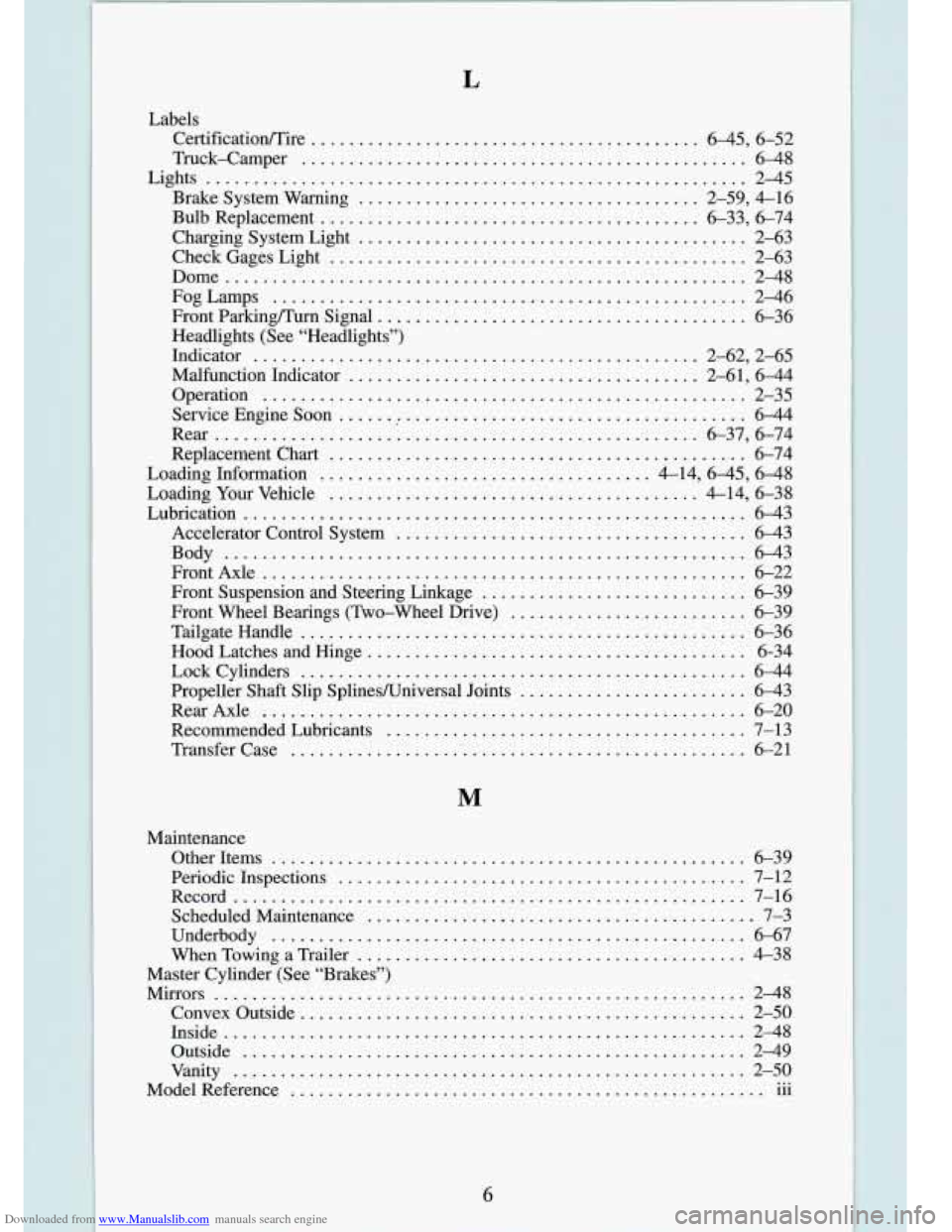
Downloaded from www.Manualslib.com manuals search engine L
Labels CertificatiodI‘ire
......................................... 6-45. 6.52
Truck-Camper
............................................... 6-48
Lights
......................................................... 2-45
Brake System Warning
.................................... 2.59. 4-16
Bulb Replacement
........................................ 6.33. 6-74
Charging System Light
......................................... 2-63
CheckGagesLight
............................................ 2-63
Dome
....................................................... 2-48
FogLamps
.................................................. 2-46
Front ParkingEurn Signal
....................................... 6-36
Headlights (See “Headlights”)
InQcator
............................................... 2.62. 2.65
Malfunction Indicator
..................................... 2.61. 6-44
Operation
................................................... 2-35
ServiceEngineSoon
........................................... 6-44
Rear
................................................... 6-37, 6-74
Replacement Chart
............................................ 6-74
Loading Information
................................... 4-14,645, 6-48
Loading Your Vehicle
....................................... 4-14, 6-38
Lubrication
..................................................... 6-43
Accelerator Control System
..................................... 6-43
Body
....................................................... 6-43
FrontAxle
................................................... 6-22
Front Suspension and Steering Linkage
............................ 6-39
Front Wheel Bearings (Two-Wheel Drive)
......................... 6-39
TailgateHandle
............................................... 6-36
HoodLatchesandHinge
........................................ 6-34
Lock Cylinders
............................................... 6-44
Propeller Shaft Slip SplinesNniversal Joints
........................ 6-43
RearAxle
................................................... 6-20
RecommendedLubricants
...................................... 7-13
Transfer Case
................................................ 6-21
M
Maintenance OtherItems
.................................................. 6-39
Record
...................................................... 7-16
ScheduledMaintenance
......................................... 7-3
Underbody
.................................................. 6-67
WhenTowingaTrailer
......................................... 4-38
Master Cylinder (See “Brakes”) Mirrors
........................................................ 2-48
Convexoutside
............................................... 2-50
Inside
....................................................... 2-48
Outside
..................................................... 2-49
Vanity
...................................................... 2-50
ModelReference
.................................................. 111
Periodic Inspections ........................................... 7-12
...
6